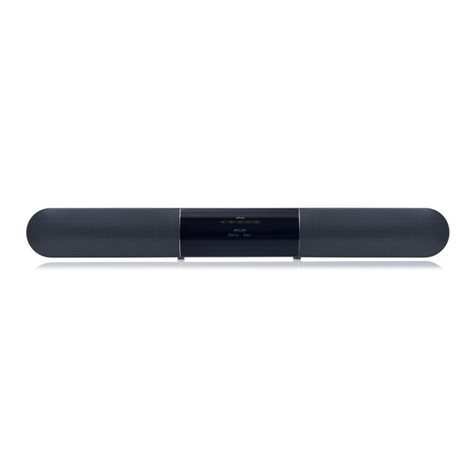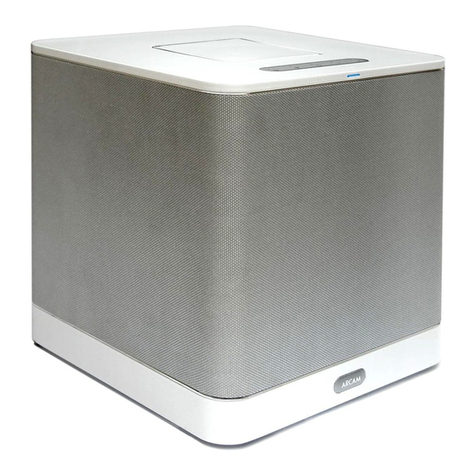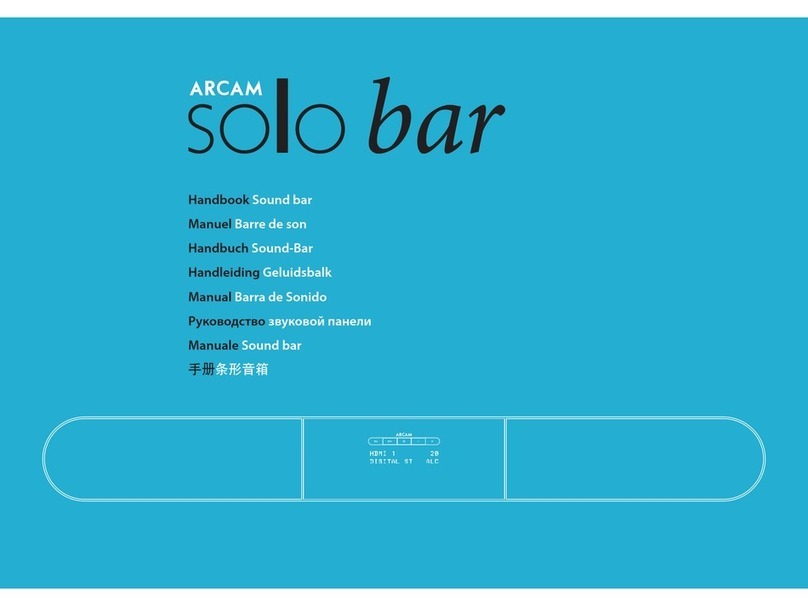Arcam SOLO MOVIE 2.1 User manual

Handbook Solo movie / music
English

E-2
… and thank you for purchasing the Arcam Solo movie/music.
Arcam has been producing specialist audio equipment of remarkable
quality for over three decades and the new Solo movie/music is the latest
in a long line of award winning Hi-Fi and home cinema products.
We hope that the care and effort we have put into building this product
will be amply demonstrated in its superior performance and reliability,
ensuring that you enjoy many years of ownership.
This handbook is a guide to installing and using the Solo movie/music. Use
the contents list on the next page to guide you to the section of interest.
We hope that your Solo movie/music will give you years of trouble-free
operation. In the unlikely event of any fault, or if you simply require further
information about Arcam products, our network of dealers will be happy
to help you. Further information can also be found on the Arcam website
at www.arcam.co.uk.
The Solo movie/music development team.
welcome...

E-3
English
contents
safety E-4
before you begin... E-6
overview E-7
front panel E-8
top panel E-9
rear panel E-10
audio/video connections E-11
other connections E-13
antenna connectors E-14
speakers E-15
disc & file formats E-16
basic operation E-17
remote control E-18
customising the remote E-22
playing a disc E-25
network/usb operation E-26
listening to radio E-27
settings menu E-28
troubleshooting E-34
technical specifications E-36
product guarantee E-38
trademarks E-39

E-4
safety
Important safety instructions
1. Read these instructions
All the safety and operating instructions should be
read before this product is operated.
2. Keep these instructions
The safety and operating instructions should be
retained for future reference.
3. Heed all warnings
All warnings on the appliance and in the operating
instructions should be adhered to.
4. Follow all instructions
All operating and use instructions should be
followed.
5. Do not use this apparatus near water
The appliance should not be used near water or
moisture – for example, in a wet basement or near a
swimming pool.
6. Clean only with dry cloth.
7. Do not block any ventilation openings. Install in
accordance with the manufacturer’s instructions.
8. Do not install near any heat sources such as
radiators, heat registers, stoves, or other apparatus
(including amplifiers) that produce heat.
9. Do not defeat the safety purpose of the polarized
or grounding-type plug. A polarized plug has two
blades with one wider than the other. A grounding
type plug has two blades and a third grounding
prong. The wide blade or the third prong are
provided for your safety. If the provided plug does
not fit into your outlet, consult an electrician for
replacement of the obsolete outlet.
10. Protect the power cord from being walked on
or pinched particularly at plugs, convenience
receptacles, and the point where they exit from the
apparatus.
11. Only use attachments/accessories specified by the
manufacturer.
12. Use only with the cart, stand, tripod, bracket, or
table specified by the manufacturer, or sold with the
apparatus. When a cart is used, use caution when
moving the cart/apparatus combination to avoid
injury from tip-over.
13. Unplug this apparatus during lightning storms or
when unused for long periods of time.
This equipment is a Class II or double insulated
electrical appliance. It has been designed in
such a way that it does not require a safety
connection to electrical earth.
Correct disposal of this product
This product contains electrical or electronic materials.
The presence of these materials may, if not disposed
of properly, have potential adverse effects on the
environment and human health. Presence of this label
on the product means it should not be disposed of as
unsorted waste and must be collected separately. As
a consumer, you are responsible for ensuring that this
product is disposed of properly.
Safety compliance
This equipment has been designed to meet the IEC/
EN 60065 international electrical safety standard.
This device complies with Part 15 of the FCC Rules.
Operation is subject to the following two conditions:
(1) This device may not cause harmful interference,
and (2) this device must accept any interference
received, including interference that may cause
undesired operation.
Use of controls or adjustments or performance of
procedures other than those specified herein may
result in hazardous radiation exposure.
14. Refer all servicing to qualified service personnel.
Servicing is required when the apparatus has been
damaged in any way, such as power-supply cord or
plug is damaged, liquid has been spilled or objects
have fallen into the apparatus, the apparatus has
been exposed to rain or moisture, does not operate
normally, or has been dropped.
15. Please keep the unit in a well-ventilated
environment.
WARNING: To reduce the risk of fire or electric shock, do not expose
this apparatus to rain, moisture, dripping or splashing. Objects
filled with liquids, such as vases should not be placed on the
apparatus.
WARNING: The mains plug or appliance coupler is used as a
disconnect device, the disconnect device shall remain readily
operable.
This lightning flash with arrowhead symbol within an equilateral
triangle is intended to alert the user to the presence of non-insulated
‘dangerous voltage’within the product’s enclosure that may be of
sufficient magnitude to constitute a risk of electric shock.
Warning: To reduce the risk of electric shock, do not remove cover
(or back) as there are no user-serviceable parts inside. Refer
servicing to qualified personnel.
The exclamation point within an equilateral triangle is intended to
alert the user to the presence of important operating and maintenance
instructions in the literature accompanying the appliance.

E-5
English
CAUTIONS ON INSTALLATION
For proper heat dispersal, do not install this
unit in a confined space, such as a bookcase
or similar enclosure.
More than 0.3 m (12 in.) is recommended
Do not place any other equipment on this
unit
SAFETY INFORMATION FOR
EUROPEAN CUSTOMERS
• Avoid high temperatures. Allow for sufficient
heat dispersion when installed in a rack
• Handle the power cord carefully. Hold the
plug when unplugging the cord
• Keep the unit free from moisture, water, and
dust
• Unplug the power cord when not using the
unit for long periods of time
• Do not obstruct the ventilation holes
• Do not let foreign objects into the unit
• Do not let insecticides, benzene, and thinner
come in contact with the unit.
• Never disassemble or modify the unit in any
way
• Ventilation should not be impeded by
covering the ventilation openings with items,
such as newspapers, tablecloths or curtains
• Naked flame sources such as lighted candles
should not be placed on the unit
• Observe and follow local regulations
regarding battery disposal
• Do not expose the unit to dripping or
splashing fluids
• Do not place objects filled with liquids, such as
vases, on the unit.
• Do not handle the mains cord with wet hands
• When the switch is in the OFF position, the
equipment is not completely switched off
from MAINS
• The equipment shall be installed near the
power supply so that the power supply is
easily accessible
FCC/IC INFORMATION FOR US AND
CANADA CUSTOMERS
1. Product
This product complies with Part 15 of the
FCC Rules/ Industry Canada licence-exempt
RSS standard(s). Operation is subject to the
following two conditions: (1) This device may
not cause harmful interference, and (2) this
device must accept any interference received,
including interference that may cause undesired
operation.
Le présent appareil est conforme aux CNR
d’Industrie Canada applicables aux appareils radio
exempts de licence. L’exploitation est autorisée
aux deux conditions suivantes : (1) l’appareil ne
doit pas produire de brouillage, et (2) l’utilisateur
de l’appareil doit accepter tout brouillage
radioélectrique subi, même si le brouillage est
susceptible d’en compromettre le fonctionnement.
Changes or modifications not expressly
approved by the party responsible for
compliance could void the user’s authority to
operate the equipment.
2. Important notice: do not modify
this product
This product, when installed as indicated in the
instructions contained in this manual, meets
FCC requirements.
Modification not expressly approved by ARCAM
may void your authority, granted by the FCC, to
use the product.
3. Note
This product has been tested and found to
comply with the limits for a Class B digital
device, persuant to Part 15 of the FCC Rules.
These limits are designed to provide reasonable
protection against harmful interference in a
residential installation.
This product generates, uses and can radiate
radio frequency energy and, if not installed
and used in accordance with the instructions,
may cause harmful interference to radio
communications. However, there is no
guarantee that interference will not occur in
a particular installation. If this product does
cause harmful interference to radio or television
reception, which can be determined by turning
the product OFF and ON, the user is encouraged
to try to correct the interference by one or more
of the following measures:
• Reorient or relocate the receiving antenna.
• Increase the separation between the
equipment and receiver.
• Connect the product into an outlet on a circuit
different from that to which the receiver is
connected.
• Consult the local retailer authorized
to distribute this type of product or an
experienced radio/TV technician for help.
FDA INFORMATION FOR US
CUSTOMERS
Complies with 21 CFR 1040.10 and 1040.11
except for deviations pursuant to Laser Notice
No. 50, dated June 24, 2007.
This product complies with IEC 60825-1:2007.
CANADA STATEMENT
This product contains IC 9088-BLR7601HL.
Operation is subject to the following two
conditions:
(1) this product may not cause harmful
interence, and (2) this product must accpet any
inteference received, including interference that
may cause undesired operation.
This Class B digital apparatus complies with
Canada ICES-003.
Under Industry Canada regulations, this
radio transmitter may only operate using
an antenna of a type and maximum (or
lesser) gain approved for the transmitter by
Industry Canada. To reduce potential radio
interference to other users, the antenna type
and its gain should be so chosen that the
equivalent isotropically radiated power (e.i.r.p.)
is not more than that necessary for successful
communication.
Conformément à la réglementation d’Industrie
Canada, le présent émetteur radio peut
fonctionner avec une antenne d’un type et d’un
gain maximal (ou inférieur) approuvé pour
l’émetteur par Industrie Canada. Dans le but de
réduire les risques de brouillage radioélectrique
à l’intention des autres utilisateurs, il faut
choisir le type d’antenne et son gain de sorte
que la puissance isotrope rayonnée équivalente
(p.i.r.e.) ne dépasse pas l’intensité nécessaire à
l’établissement d’une communication satisfaisante.
MPE Reminding
To satisfy FCC / IC RF exposure requirements, a
separation distance of 20 cm or more should be
maintained between the antenna of this device
and persons during device operation. To ensure
compliance, operations at closer than this
distance is not recommended.
Les antennes installées doivent être situées de
facon à ce que la population ne puisse y être
exposée à une distance de moin de 20 cm. Installer
les antennes de facon à ce que le personnel ne
puisse approcher à 20 cm ou moins de la position
centrale de l’ antenne. La FCC des éltats-unis stipule
que cet appareil doit être en tout temps éloigné
d’au moins 20 cm des personnes pendant son
functionnement.
zz
z
Wall
z
A NOTE ABOUT RECYCLING
This product’s packaging materials are
recyclable and can be reused. Please dispose
of any materials in accordance with the local
recycling regulations. When discarding the
unit, comply with local rules or regulations.
Batteries should never be thrown away or
incinerated but disposed of in accordance
with the local regulations concerning battery
disposal. This product and the supplied
accessories, excluding the batteries,
constitute the applicable product according
to the WEEE directive.
CORRECT DISPOSAL OF THIS
PRODUCT
These markings indicate that this product
should not be disposed with other household
waste throughout the EU. To prevent possible
harm to the environment or human health
from uncontrolled waste disposal and to
conserve material resources, this product
should be recycled responsibly.
To dispose of your product, please use
your local return and collection systems or
contact the retailer where the product was
purchased.
Other manuals for SOLO MOVIE 2.1
2
This manual suits for next models
2
Table of contents
Other Arcam Speakers System manuals






















